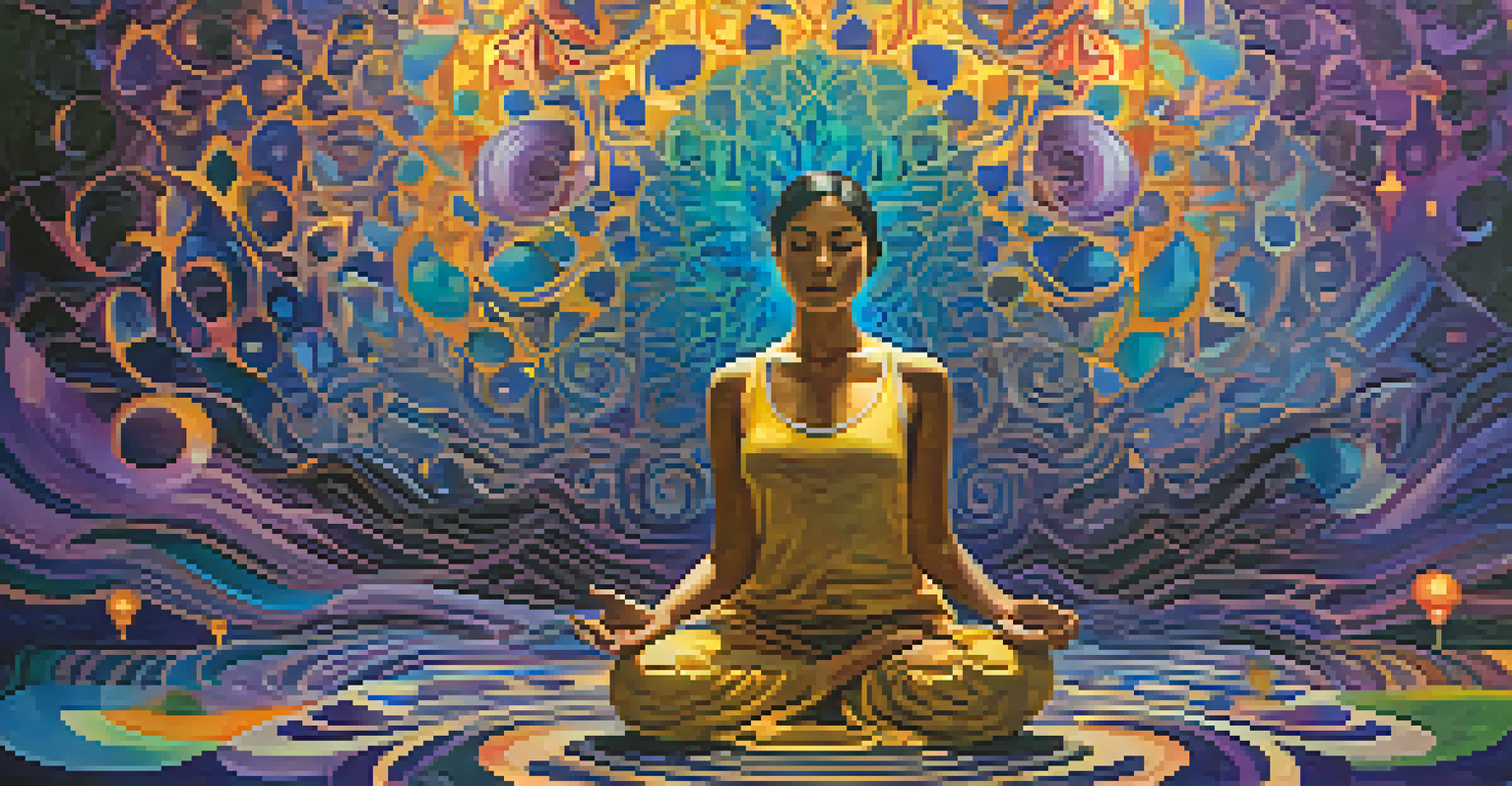The Role of DMT in Ayahuasca and Brain Function Alterations

What is DMT and Its Significance in Ayahuasca?
DMT, or dimethyltryptamine, is a powerful psychedelic compound found in various plants and animals. In the context of ayahuasca, it is derived primarily from the Banisteriopsis caapi vine and the Psychotria viridis leaf. This combination creates a brew that has been used for centuries in traditional Amazonian shamanic practices, leading to profound spiritual and psychological experiences.
DMT is not just a psychedelic; it is a powerful tool for self-discovery and healing.
The significance of DMT in ayahuasca lies in its ability to induce altered states of consciousness. Many users report experiencing intense visual hallucinations, emotional catharsis, and deep introspection. This unique experience is often described as a journey through the self, providing insights that can promote healing and personal growth.
Moreover, DMT is often referred to as the 'spirit molecule' due to its association with mystical experiences. These experiences can foster a sense of interconnectedness with the universe, which many find transformative. Understanding DMT's role in ayahuasca is crucial for grasping its potential impact on human consciousness.
How Ayahuasca Works in the Brain
Ayahuasca functions primarily through its interaction with serotonin receptors in the brain. The main active compounds, including DMT and harmala alkaloids, influence pathways that regulate mood, perception, and cognition. This interaction can lead to significant alterations in consciousness, allowing users to explore their psyche in ways that are often not possible in everyday life.

Once ingested, DMT is rapidly broken down by the enzyme monoamine oxidase (MAO), but the presence of harmala alkaloids in ayahuasca inhibits this enzyme, allowing DMT to remain active longer in the body. This extended duration amplifies the effects, leading to profound experiences that can last several hours. The unique synergy between these compounds creates a powerful tool for exploration and healing.
DMT's Role in Ayahuasca
DMT, found in ayahuasca, induces profound psychological and spiritual experiences that can promote healing and personal growth.
Research into ayahuasca and DMT suggests that these substances can promote neuroplasticity, which is the brain's ability to reorganize itself by forming new neural connections. This plasticity may enhance emotional resilience and facilitate recovery from trauma, making ayahuasca a topic of increasing interest in the fields of psychology and neuroscience.
The Psychological Effects of DMT in Ayahuasca
Many individuals who consume ayahuasca report significant psychological effects, including heightened emotional awareness and cognitive clarity. This can manifest as a deeper understanding of personal issues, relationships, and life choices. The introspective nature of the experience often allows for profound realizations that can lead to lasting change.
The experience of ayahuasca is like a mirror reflecting your deepest truths.
Additionally, the intense visuals and emotional experiences associated with DMT can help users confront unresolved traumas or fears. This cathartic process can facilitate emotional healing and promote a sense of closure. Anecdotal evidence suggests that such experiences can result in improved mental health outcomes for some participants.
However, it's important to note that the psychological effects of ayahuasca can vary widely among individuals. While many find it beneficial, others may experience challenging emotions or confront difficult memories. This duality highlights the importance of setting and guidance in navigating the ayahuasca experience.
DMT and Its Influence on Spiritual Experiences
DMT's role in ayahuasca is not just limited to psychological effects; it also plays a significant part in spiritual experiences. Many users report feeling a connection to a higher power or the universe itself, which can be deeply transformative. This sense of spirituality is often described as a feeling of oneness or unity with all existence.
These spiritual experiences can lead to a shift in perspective, encouraging individuals to reevaluate their beliefs and values. For some, the insights gained during an ayahuasca ceremony can result in a renewed sense of purpose or direction in life. This transformative potential has fueled interest in ayahuasca as a means of spiritual exploration.
Neuroscience of Ayahuasca
Ayahuasca interacts with serotonin receptors, allowing for significant alterations in consciousness and promoting neuroplasticity.
Moreover, the communal aspect of ayahuasca ceremonies often enhances these spiritual experiences. Participants frequently share their journeys with one another, fostering a sense of community and support. This collective aspect can amplify the profound nature of the experience, making it even more impactful.
Scientific Research on DMT and Ayahuasca
In recent years, scientific interest in DMT and ayahuasca has grown, leading to various studies exploring their effects on the brain and consciousness. Researchers are particularly interested in understanding how these compounds can influence mental health and well-being. Preliminary findings suggest that ayahuasca can alleviate symptoms of depression and anxiety in some individuals.
One major avenue of research focuses on the neurobiological mechanisms underlying these effects. Studies using brain imaging technologies have shown changes in brain activity patterns during ayahuasca experiences, particularly in areas related to self-awareness and emotional processing. These changes may offer insights into how ayahuasca can facilitate therapeutic outcomes.
However, while the research is promising, it's essential to approach these findings with caution. The subjective nature of psychedelic experiences means that individual responses can vary greatly. Ongoing research aims to further elucidate the therapeutic potential of DMT and ayahuasca and how they can be safely integrated into mental health treatment.
Potential Risks and Considerations of Ayahuasca Use
While many individuals report positive experiences with ayahuasca, it's crucial to acknowledge the potential risks involved. The intense psychological experiences can sometimes lead to overwhelming emotions or challenging insights, which may not be suitable for everyone. Individuals with a history of mental health issues should approach ayahuasca with caution and seek professional guidance.
Additionally, the physical effects of ayahuasca can include nausea and vomiting, which are often considered a part of the purging process. While some view this as a cleansing experience, others may find it uncomfortable. It's essential for participants to be prepared for these physical aspects of the journey.
Integration of Experiences
Post-ayahuasca, individuals often seek to integrate their insights into daily life through mindfulness and reflection for lasting change.
Lastly, the legal status of ayahuasca varies by country, and it is important to be aware of local laws before participating in a ceremony. Ensuring that the ceremony is conducted by experienced and reputable facilitators can also help mitigate risks and enhance the overall experience.
Integrating Ayahuasca Experiences into Daily Life
After participating in an ayahuasca ceremony, many individuals seek ways to integrate their experiences into their daily lives. This process can involve reflecting on insights gained and considering how these lessons can inform future decisions. Journaling or discussing experiences with trusted friends can help solidify these insights and facilitate personal growth.
Mindfulness practices, such as meditation or yoga, can also support the integration process. These practices encourage self-awareness and help individuals stay connected to the insights gained during their ayahuasca journey. Establishing a routine that incorporates these practices can foster ongoing emotional and spiritual development.

Ultimately, the integration of ayahuasca experiences can lead to lasting change. By consciously applying insights and lessons learned, individuals can enhance their overall well-being and navigate life's challenges with newfound clarity and resilience.